Pictures of Howard Staunton
Presented by Edward Winter
ONE:
In C.N. 5259 Gene Gnandt (Houston, TX, USA) raised the subject of the 1843 illustration of Staunton v Saint Amant, which has been widely published (e.g. as a supplement to the November 1911 issue of La Stratégie). Noting that a key was given on pages 325-326 of volume two of Geschichte und Litteratur des Schachspiels by A. van der Linde (Berlin, 1874), our correspondent added numbers in the reproduction below:
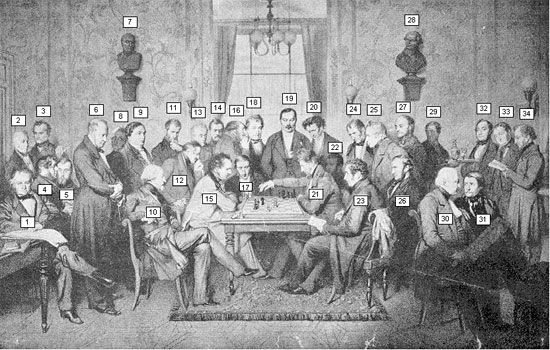

Mr Gnandt commented:
‘At least two of the figures are inconsistent with the key: “General Graf Duchaffault” (8) appears to the left of the “Büste des Labourdonnais” (7) while “Delaubier” (20) is clearly to the right of “St.-Amant” (21). These inconsistencies make me wonder about the correctness of the key as a whole. Can anyone confirm the identities of all the figures?’
We added that when the picture was given as the frontispiece to the February 1899 BCM ‘J.A.L.’ wrote on page 49 of that issue:
‘The original painting, after which the engraving was produced, is by Marlet, and in connection with it it is curious to note that its publication by the Palamède led to a lawsuit, in which St Amant was involved in his capacity of editor of that celebrated chess periodical. It appears that St Amant bought the painting of the artist for 500 francs, and handed it over to the engraver, Laemlein. The latter did not engrave from the original, but in the first instance made a copy of the painting, in which he substituted several well-known characters in the chess world for some of the persons in the original. As a consequence of these alterations, St Amant considered he was dealing with a fresh picture, and on publication he therefore only suffixed the name of the engraver. Thereupon Marlet brought an action against the Palamède for publishing his picture without his consent, and likewise for damages for the omission of his name. The first part of the action was dismissed, as it was held that the artist, in selling his picture, ceded all his rights to the purchaser. For the omission of his name he was awarded 200 francs damages, and St Amant was ordered to have Marlet’s name added to all future copies.’
For further details about the painting, and a reference to a slightly different key, see C.N. 5395, which provides a link to information we received from Etienne Cornil (Brussels).
TWO:
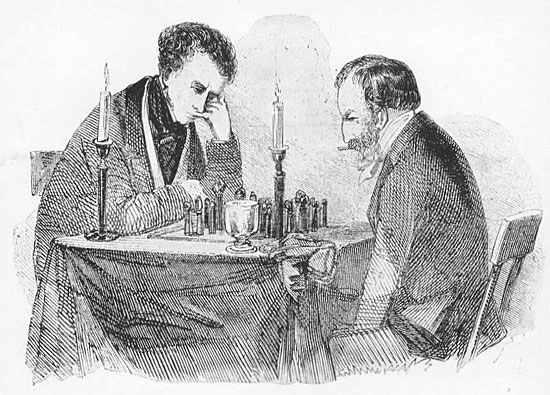
Howard Staunton and Bernhard Horwitz
Information is sought regarding the origins of this illustration, which was a Beilage in the 2 October 1910 issue of Deutsches Wochenschach.
THREE:
C.N. 5990 gave this well-known shot from the Leamington meeting of 1855 (from left to right: Löwenthal, de Rivière, Wyvill, Falkbeer, Staunton, Lyttelton and Kennedy):
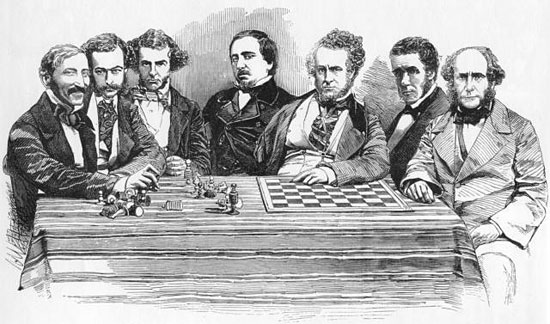
As shown in the link provided in the discussion on illustration Five below, the group picture was published on page 44 of the Illustrated London News, 14 July 1855.
In C.N. 5976 Michael Clapham (Ipswich, England) provided from his collection this tinted version:
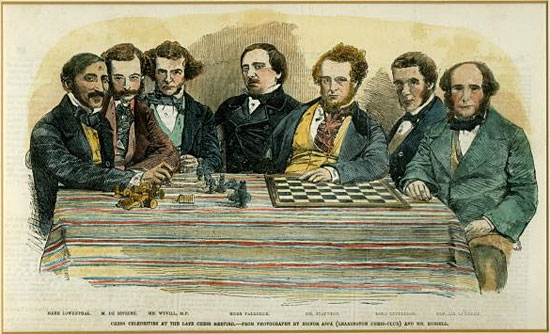
Mr Clapham also reported that page 166 of The Chess-Player’s Annual for 1856 edited by Charles Tomlinson (London, 1856) mentioned photographs taken by Rosario Aspa at Leamington:

Paul Dorion (Montreal, Canada) noted in C.N. 5990 the close similarities in the portrayal of Staunton (third from the right) and the picture of him which is given below as portrait Four. The two illustrations appeared on pages 22 and 24 respectively of Fred Wilson’s A Picture History of Chess (New York, 1981).
FOUR:
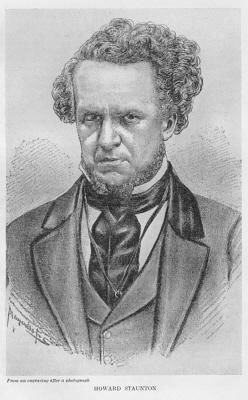
Regarding the above picture, another correspondent, John Townsend (Wokingham, England), remarked in C.N. 5998 that it appeared opposite page 164 of A Century of British Chess by P.W. Sergeant (London, 1934) with the reference ‘From an engraving after a photograph’. Mr Townsend also commented:
‘The name in the bottom left-hand corner is hard to read; the first word may be something like “Maguille”.’
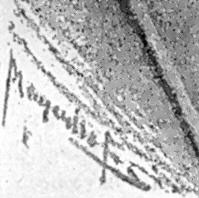
The illustration had been given on page 193 of the March 1890 Chess Monthly, and the following month (page 225) there was a portrait of Emanuel Lasker with the same signature. A similar sketch of Staunton, though from the twentieth century, was by Alexander Forrest and appeared on page 70 of The Chess-player’s Week-end Book by R.N. Coles (London, 1950).
FIVE:

From opposite page 96 of the 1859 US edition of F.M. Edge’s book on Morphy.
In C.N. 5958 Gene Gnandt wrote:
‘On pages v-vi of his Preface to The Exploits and Triumphs, in Europe, of Paul Morphy, The Chess Champion (New York, 1859) Frederick M. Edge gave sources for the sketches in his book:
“The cuts with which this work is embellished have been engraved by the well-known Brothers Dalziel ...
The portraits of Messrs Staunton, Boden, Anderssen and Löwenthal are copies of photographs, for which they sat at the Manchester Meeting, in 1857.”
The photographs themselves, therefore, may have gone unpublished.
The earliest reference to photographs of masters that I was able to find comes with regard to a well-known sketch which appeared on page 44 of the Illustrated London News, 14 July 1855. Over 40 years later, Rosario Aspa wrote a letter to the BCM (August 1896, pages 331-332) about Marmaduke Wyvill. He remarked in part:
“In those days I had already become an ardent amateur photographer and, needless to say, I did not let this opportunity go by of securing portraits of so many great chessplayers. A week or two after the meeting, the Illustrated London News gave in woodcuts from my negatives the six players of the match just described, Lord Lyttelton, the president of the meeting, sitting in their midst. I have been told that the portrait of Staunton is the only one known, and in the group Mr Marmaduke Wyvill will be found sitting at his right hand.”’
We wondered whether it was known what became of Aspa’s archives (his obituary on page 231 of the June 1905 BCM reported that he died in Leamington), and in C.N. 5979 Tim Harding (Dublin) wrote:
‘... his scrapbooks are in the John G. White Collection in Cleveland under the following references:
“ASPA, ROSARIO
Chess articles, games, problems and game endings by Rosario Aspa; collected from his papers and arranged by John G. White.
789.32M AS61C2
Chess miscellanies: games, problems and game endings. Q 789.31 O1A V.1 AND V2.”’
Finally, it may be added that the illustration of Staunton alone was given opposite page 465 of the November 1908 BCM and as the Beilage in the 3 July 1910 issue of Deutsches Wochenschach:
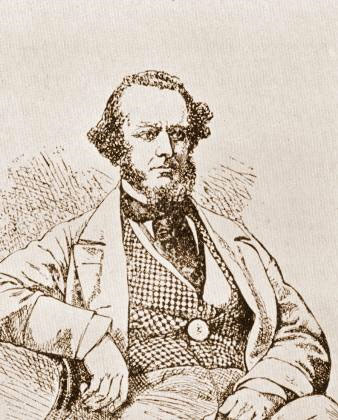
SIX:

The above photograph was published on page 102 of Paul Morphy The Pride and Sorrow of Chess by David Lawson (New York, 1976), but a detail had appeared on page 56 of the January-February 1964 issue of Chessworld (to which Lawson was a contributor):
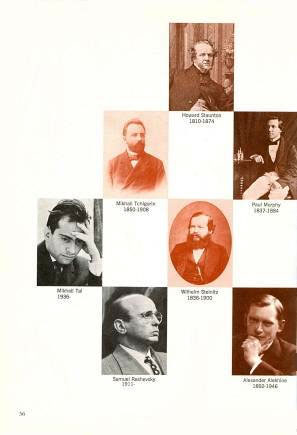

In C.N. 5998 Michael McDowell (Westcliff-on-sea, England) observed that the full Staunton photograph had been given on page 84 of The World of Chess by A. Saidy and N. Lessing (New York, 1974), credited to Lawson on page 248. We do not recall any pre-1964 source which gave the photograph either in full or in part.
SEVEN:
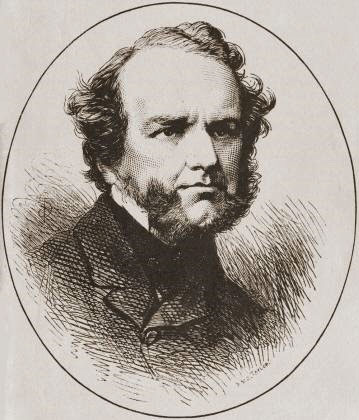
Gene Gnandt observed in C.N. 5958:
‘I believe that the photograph of Howard Staunton [see Six above] was used as a basis for an engraving by, if I read the initials correctly, P.M.E. Taylor. The engraving appeared in Staunton’s obituary in the Illustrated London News of 4 July 1874.’
EIGHT:

In C.N. 3397 (see pages 285-286 of Chess Facts and Fables) we mentioned that Samuel Loyd reproduced his sketches/woodcuts in the Scientific American Supplement, one per week during the column’s run from 11 August 1877 to 3 August 1878. The Staunton illustration above appeared on 6 October 1877 (page 1470), and Loyd wrote:
‘I have placed on the board a little five-move knight problem that I showed to him during my last visit to London. I dare say a microscopic observation would reveal the two-move position on the back of the book.’
We managed to identify the board position as a composition by Loyd published on page 103 of the Chess Monthly, April 1858 (although the pieces are in the bottom left, and not bottom right, corner):
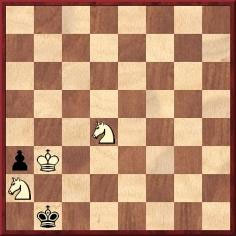
Mate in five: 1 Nc6 Ka1 2 Kc2 Kxa2 3 Nb4+ Ka1 4 Kc1 a2 5 Nc2.
C.N. 3745 reported our discovery of the picture on which the sketch by Loyd was evidently based:

This comes from a 6x6 composite photograph of chess figures in our possession:

A larger version can be viewed by clicking here.
Can a better-quality copy of the Staunton picture, and some of the others, be found?
NINE:
C.N. 3451 gave the following portrait of Howard Staunton which had appeared, in very small format, on page 394 of the October 1911 issue of the Chess Amateur:

In C.N. 3467 Owen Hindle (Cromer, England) reported that it had featured in the ‘Champions of British Chess’ illustration on page 173 of the October 1898 American Chess Magazine:

For a larger version, click here.
Our correspondent also pointed out that in a feature on page 183 of the Chess Players’ Quarterly Chronicle, 1870 H. Meyer announced:
‘We have in view the publication of a Photographic Chess-board, containing (arranged on the squares) the portraits of 64 English composers. The Carte will be similar to the American Chess-board lately introduced to the chess community by Mr Loyd. ... We may also add a few chessplayers (not known as composers), whose portraits we have ... so as to complete the required number. A subscriber of half a crown will be entitled to a proof copy of the Cartes as soon as they are issued.’
Finally, Mr Hindle sent us a copy of I.O. Howard Taylor’s chess column in the Eastern Daily Press of 2 December 1871, which stated, ‘Mr Henry Meyer, the well-known problematist and chess editor, has brought out a Photographic Chess Board’. The chess personalia listed in the column’s description correspond to those in the above illustration.
A standard-size copy of the Staunton portrait remains to be found.
TEN:

This sketch by Wallis Mackay was published on page 2 of Chess Life-Pictures by G.A. MacDonnell (London, 1883).
ELEVEN:
Michael McDowell asked in C.N. 5614 about the photograph referred to as follows at the website of the Lewis Carroll Society:
‘Chess-Players, August 1866
This photograph, in Album P(3) of the Morris L. Parrish collection in Princeton University, was kept by Lewis Carroll but probably not taken by him. Almost certainly it shows thirty of the contestants and guests at the Redcar chess congress that Lewis Carroll attended on 10 August 1866. Most have not been identified, but Cecil de Vere, the winner of the main tournament, is pictured (the tall young man left of centre standing with his arms folded). To his left in front, seated holding his top hat is Howard Staunton. Two chess problemists, Walter Grimshaw (in the centre at the back, just to the right of Howard Staunton) and Henry E. Kidson (standing to the left and behind the seated gentleman with a stick on the right) are also probably identifiable.
This photograph is reproduced in (Taylor, page 205).’
The website does not give the photograph, and in C.N. 5614 we were able to express gratitude to the Princeton University Press for permission to reproduce it, from the fine book referred to above, Lewis Carroll Photographer by Roger Taylor and Edward Wakeling (Princeton and Oxford, 2002):

The caption reads as follows:

For a larger version of the photograph, click here. Below is a detail of Howard Staunton:

An account of the Redcar tournament appeared on pages 194-196 of the 1866 volume of Staunton’s periodical the Chess World. Organizational shortcomings were referred to (including ‘a want of liberality, a want of hospitality in the arrangements’), after which those in attendance were listed:
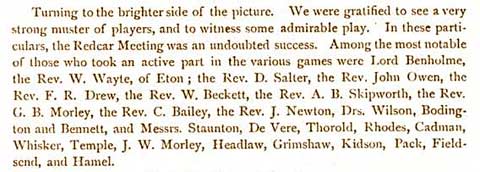
In the present article we have left aside caricatures of Staunton (see, for instance, page 23 of the above-mentioned book by Fred Wilson). No compilation can, in any case, hope to be complete. Tantalizing reports are occasionally found in chess literature, and one instance was quoted in C.N. 3995, from page 129 of the April 1930 BCM:
‘A very interesting meeting of the Executive Committee of the British Chess Federation was held in London, on 8 March. Major Sir Richard Barnett, who was in the chair, very kindly offered to purchase and present to the Federation an oil painting of Howard Staunton, dated 1846 ...’
This report was briefly mentioned in C.N. 1136 (see page 193 of Chess Explorations), but no further information about the portrait has come to our attention.
See also our feature articles:
Edge, Morphy and Staunton
Attacks on Howard Staunton
Early Uses of ‘World Chess Champion’.
Submit information or suggestions on chess explorations
All ChessBase articles by Edward Winter
 aficionados to discuss all matters relating to the Royal Pastime". Since then over 6,000 items have been published, and the series has resulted in four books by Winter: Chess Explorations (1996), Kings, Commoners and Knaves (1999), A Chess Omnibus (2003) and Chess Facts and Fables (2006). He is also the author of a monograph on Capablanca (1989).
aficionados to discuss all matters relating to the Royal Pastime". Since then over 6,000 items have been published, and the series has resulted in four books by Winter: Chess Explorations (1996), Kings, Commoners and Knaves (1999), A Chess Omnibus (2003) and Chess Facts and Fables (2006). He is also the author of a monograph on Capablanca (1989).
Chess Notes is well known for its historical research, and anyone browsing in its archives will find a wealth of unknown games, accounts of historical mysteries, quotes and quips, and other material of every kind imaginable. Correspondents from around the world contribute items, and they include not only "ordinary readers" but also some eminent historians – and, indeed, some eminent masters. Chess Notes is located at the Chess History Center. Signed copies of Edward Winter's publications are currently available.











































 aficionados to discuss all matters relating to the Royal Pastime". Since then over 6,000 items have been published, and the series has resulted in four books by Winter:
aficionados to discuss all matters relating to the Royal Pastime". Since then over 6,000 items have been published, and the series has resulted in four books by Winter: 




